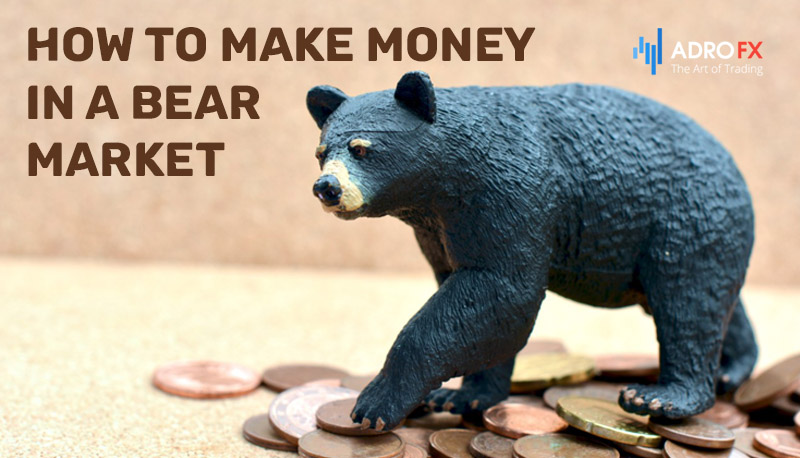A Detailed Explanation and Definition of a Bear Market

In the unpredictable landscape of financial markets, investors often find themselves navigating through various economic cycles, each accompanied by its unique set of challenges and opportunities. Among these cycles, a "bear market" stands as a formidable force, capable of shaking the foundations of even the most stable investments. While the term "bear market" is frequently mentioned in financial news and discussions, its true implications and consequences may remain shrouded in mystery for many.
This article aims to demystify the enigma of bear markets by providing a detailed explanation and definition of this crucial economic phenomenon. As we embark on this insightful journey, we will delve into the core aspects of bear markets, shedding light on their characteristics, causes, and historical precedents. By grasping the essence of bear markets, investors and financial enthusiasts alike can equip themselves with the knowledge needed to better comprehend and respond to these turbulent periods.
What Is the Bear Market Definition?
In the realm of finance, a bear market is a term used to describe a prolonged period of decline in the value of a specific market, typically lasting for several weeks or even months. During this phase, investor sentiment is predominantly pessimistic, leading to a substantial decrease in asset prices across various sectors. The bear market phenomenon is often driven by a pervasive sense of fear, uncertainty, and doubt, as investors become increasingly apprehensive about the future prospects of their investments. As a result, trading volumes may dwindle, and market liquidity can diminish, exacerbating the downward spiral. One of the key thresholds used to define a bear market is the decline of a particular market or index by 20% or more from its recent peak. While bear markets can be challenging and unsettling for investors, they are an intrinsic part of the economic cycle, offering valuable opportunities for reevaluating investment strategies and identifying undervalued assets. Understanding the bear market definition is fundamental for investors to navigate these tumultuous periods and make well-informed decisions in safeguarding their financial interests.

Signs Pointing Toward a Pending Bear Market
Identifying early warning signs of an impending bear market is a crucial skill for investors looking to protect their portfolios and make strategic adjustments. While the financial markets can be unpredictable, certain indicators often hint at the approach of a bearish trend. Below are some of the key signs to watch out for:
- Economic Indicators Slowdown: Economic indicators such as GDP growth, employment rates, and manufacturing data can offer valuable insights into the overall health of an economy. A bear market might be on the horizon if these indicators show a significant slowdown or contraction.
- Inverted Yield Curve: When the yield curve inverts, meaning short-term interest rates become higher than long-term rates, it has historically preceded many bear markets. An inverted yield curve can be an ominous signal of impending economic challenges.
- Declining Corporate Earnings: Corporate earnings play a crucial role in influencing stock prices. A series of declining earnings reports from major companies across different sectors may indicate a broader economic downturn.
- Increasing Unemployment: A rise in unemployment rates can lead to reduced consumer spending, affecting businesses and stock prices negatively. Persistent job losses could foreshadow a bear market.
- High Valuations and Overbought Conditions: When stock prices become excessively inflated, it often indicates an overbought market. High price-to-earnings ratios and stretched valuations may be unsustainable, potentially triggering a market correction or bearish trend.
- Weakening Consumer Confidence: Consumer confidence is a key driver of economic activity. A decline in consumer sentiment may lead to reduced spending, impacting businesses and stock markets alike.
- Global Events and Geopolitical Uncertainty: Geopolitical tensions, trade disputes, or unexpected global events can disrupt financial markets, leading to increased volatility and the potential onset of a bear market.
- Deteriorating Market Breadth: A narrowing breadth in the stock market, where fewer individual stocks are participating in the rally, can be a sign of waning investor enthusiasm and potential market weakness.
- Increased Volatility: Heightened market volatility is often associated with bearish trends, as uncertainty and fear grip investors, causing rapid and unpredictable price fluctuations.
- Technical Indicators and Bearish Patterns: Chart patterns, such as the "death cross" where the short-term moving average crosses below the long-term moving average, or a series of lower highs and lower lows, may signal an impending bear market.
While these signs can provide valuable insights, it's essential to remember that bear markets are complex and multifaceted phenomena. No single indicator can predict market movements with absolute certainty. Investors should approach the analysis with a holistic perspective and seek professional advice to make informed decisions amidst evolving market conditions.
Understanding How a Bear Market Works
A bear market operates as a forceful counterpoint to the exuberance of bull markets, thrusting investors into a period of prolonged pessimism and declining asset values. To grasp the inner workings of a bear market, one must delve into its defining characteristics and the factors driving its dynamics.
Market Sentiment
A bear market is primarily fueled by a prevailing sense of fear, uncertainty, and negative sentiment among investors. As negative news and economic indicators mount, confidence erodes, leading to widespread selling pressure.
A Downturn in Asset Prices
Across various financial markets, bearish trends manifest as a persistent decline in asset prices. Stocks, commodities, real estate, and other investment instruments experience falling values, sometimes resulting in substantial losses for investors.
Impact on Investors
In a bear market, investors often experience a psychological shift, from optimism and a willingness to take risks during bull markets to heightened caution and a desire to preserve capital. This shift can lead to reduced buying activity and increased selling, exacerbating the downward trajectory.
Duration and Magnitude
Bear markets can vary in length and severity. Some may be relatively short-lived and shallow, while others can extend for months or even years, with significant price corrections. The depth of the decline may be influenced by the underlying causes and the extent of market exuberance during the preceding bull phase.
Causes of Bear Markets
Numerous factors can trigger a bear market. Economic recessions, geopolitical instability, policy changes, inflation, and bursting asset bubbles are just a few examples of potential catalysts. A combination of these factors often amplifies the bearish sentiment.
Sector-Specific Trends
Within a bear market, specific sectors or industries may be more severely impacted than others. Investors may seek refuge in defensive sectors such as utilities or consumer staples, while cyclical sectors like technology and consumer discretionary may face more significant downturns.
Opportunities Amidst Adversity
Despite their challenging nature, bear markets can present unique opportunities for investors. Valuations of quality assets may become more attractive, allowing investors to acquire stocks at discounted prices. Additionally, safe-haven assets like gold and bonds tend to perform better during bearish phases.

What Is the Difference Between a Secular and Cyclical Bear Market?
Bear markets can be further categorized into two distinct types: secular and cyclical bear markets. Understanding the differences between these classifications is crucial for comprehending the broader market cycle.
- Cyclical Bear Market
A cyclical bear market is a temporary phase of market decline within an ongoing bull market cycle. These bearish periods typically last for several months, and the decline in asset prices may range from moderate to severe. Cyclical bear markets are considered corrections, and they occur due to various short-term factors such as economic downturns, industry-specific challenges, or changes in monetary policy. Once the issues causing the downturn are addressed or subside, the market tends to recover, leading to a resumption of the overall upward trend.
- Secular Bear Market
In contrast, a secular bear market is an extended and more prolonged phase of market decline, typically lasting for years or even a decade. Unlike cyclical bear markets, secular bear markets occur within the context of a more extended market cycle, where the overall trend is stagnant or downward. Secular bear markets are characterized by a series of cyclical bear markets interspersed with smaller bull market phases. Structural economic challenges, high valuations, and long-term demographic shifts can contribute to the protracted nature of a secular bear market.
Distinguishing between cyclical and secular bear markets is vital for investors, as the strategies and outlook during each type of bear market may differ significantly. While cyclical bear markets may present opportunities for tactical buying and selling, secular bear markets call for more defensive and conservative investment approaches to protect against prolonged downturns.
An Illustration of a Bear Market
Presently, the global financial system is undergoing a challenging phase known as a bear market. Inflation rates have reached levels not witnessed since World War II, and this, coupled with disappointing earnings and pessimistic outlooks, has led to supply chain disruptions, reduced consumer confidence, a land war in continental Europe, and an overall slowdown in the economy. The last major bear market occurred between 2007 and 2009, triggered by the global financial crisis that originated in the heavily regulated US housing sector. Unfortunately, warning signs about the impending mortgage crisis were largely ignored as equity markets reached unprecedented highs. Investors and traders remained undeterred by economic warnings, celebrating the rising housing values and maintaining a bullish sentiment throughout their daily trading activities.
However, the housing bubble eventually burst, causing mortgage defaults to skyrocket, leading to the collapse of prominent financial institutions like Lehman Brothers and Bear Stearns. As a result, the government had to intervene with forced takeovers of other firms such as Morgan Stanley, and substantial taxpayer-funded bailouts were necessary. The US markets witnessed a staggering 50%+ decline, sending shockwaves across the global financial landscape. Many international banks and asset managers suffered colossal losses due to their involvement in the US housing market frenzy.
The bear market hit its lowest point in March 2009, followed by a sharp equity market rally, rewarding patient investors who took advantage of the significant sell-off. Central banks played a crucial role in creating an artificial bull market through easy monetary policies, leading to the longest-lasting bull market in US history, briefly interrupted by the Covid-19 pandemic-induced technical bear market.
Following a steep 33% decline, markets rebounded to reach new all-time highs, but this apparent bull trap has now raised concerns of another massive bear market. Some fear that this could potentially burst the "everything bubble" that has been created by central banks, surpassing the impact of the 2007-2009 bear market. As such, the current bear market might persist for several months, or even longer. In light of this situation, investors should carefully consider bear market investing, as the cycles of bear and bull markets are bound to continue offering opportunities.

How To Benefit From A Bear Market
While bear markets can be daunting and challenging for investors, they also present unique opportunities to capitalize on declining asset prices and potentially benefit from market downturns. Here are several strategies and techniques that investors can consider to capitalize in a bear market:
- Short Selling: Short selling involves borrowing shares of a stock or an asset from a broker and selling them with the expectation that their price will decline. Once the price drops, the investor can buy back the shares at a lower price, return them to the broker, and pocket the difference as a return.
- Inverse Exchange-Traded Funds (ETFs): Inverse ETFs are designed to perform inversely to the underlying index they track. For example, if the stock market index goes down, an inverse ETF tied to that index would rise. These funds can provide a straightforward way to take advantage of a bearish market.
- Defensive Stocks: During bear markets, investors often seek refuge in defensive stocks or industries, which tend to be less sensitive to economic downturns. Companies that provide essential goods or services, like utilities or healthcare, may perform relatively better during market declines.
- Dividend Investing: Some companies continue to pay dividends even during bear markets. Investing in dividend-paying stocks can provide a source of income during downturns, and reinvesting those dividends can help compound returns over time.
- Dollar-Cost Averaging: Rather than investing a lump sum, consider dollar-cost averaging by investing a fixed amount at regular intervals. This approach can help mitigate the risk of investing at market peaks and potentially benefit from buying assets at lower prices during a bear market.
- Value Investing: Adopt a value investing approach by identifying fundamentally strong companies whose stocks are undervalued due to market pessimism. Buying these stocks at a discount during a bear market can lead to long-term gains when market sentiment eventually improves.
- Precious Metals: Historically, precious metals like gold and silver have served as safe-haven assets during times of market uncertainty. Investing in physical metals or related exchange-traded funds (ETFs) can provide a hedge against market volatility.
- Rebalancing and Asset Allocation: Regularly review and rebalance your investment portfolio to align with your risk tolerance and long-term goals. Diversifying across various asset classes can help manage risk during market fluctuations.
It is essential to remember that bear markets can be unpredictable and volatile. While these strategies can provide potential return opportunities, they also carry inherent risks. Investors should conduct thorough research, and consider their risk tolerance before implementing any investment strategy in a bear market. Maintaining a long-term perspective and disciplined approach to investing can help navigate through market cycles and increase the likelihood of achieving financial goals over time.
About AdroFx
Established in 2018, AdroFx is known for its high technology and its ability to deliver high-quality brokerage services in more than 200 countries around the world. AdroFx makes every effort to keep its customers satisfied and to meet all the trading needs of any trader. With the five types of trading accounts, we have all it takes to fit any traders` needs and styles. The company provides access to 115+ trading instruments, including currencies, metals, stocks, and cryptocurrencies, which make it possible to make the most out of trading on the financial markets. Considering all the above, AdroFx is the perfect variant for anyone who doesn't settle for less than the best.










